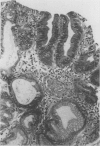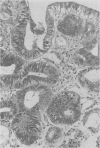Abstract
The natural history of gastric epithelial dysplasia and its relation to gastric cancer are ill defined. A consecutive series of 40 patients with an initial diagnosis of gastric epithelial dysplasia based on examination of endoscopic biopsies has been reviewed to determine the clinical outcome and to evaluate a two tier histological grading system as a predictor of the risk of cancer. On review, only 20 of the 40 patients were considered to have true dysplasia: seven patients had low grade dysplasia and 13 had high grade dysplasia. Of the 13 patients with high grade dysplasia, 11 (85%) were found to have gastric cancer within 15 months. Of the 10 patients with high grade dysplasia who underwent gastrectomy, six were found to have early gastric cancer, three had cancer invading into the muscularis propria, and none had lymph node metastases. High grade dysplasia is thus a marker of gastric cancer. Moreover, the cancers associated with high grade dysplasia are usually pathologically favourable and curable. The finding, by an experienced pathologist, of high grade dysplasia in two separate sets of endoscopic biopsies is therefore an indication for radical surgical treatment, provided that the patient's age and general condition permit such an approach.
Full text
PDF
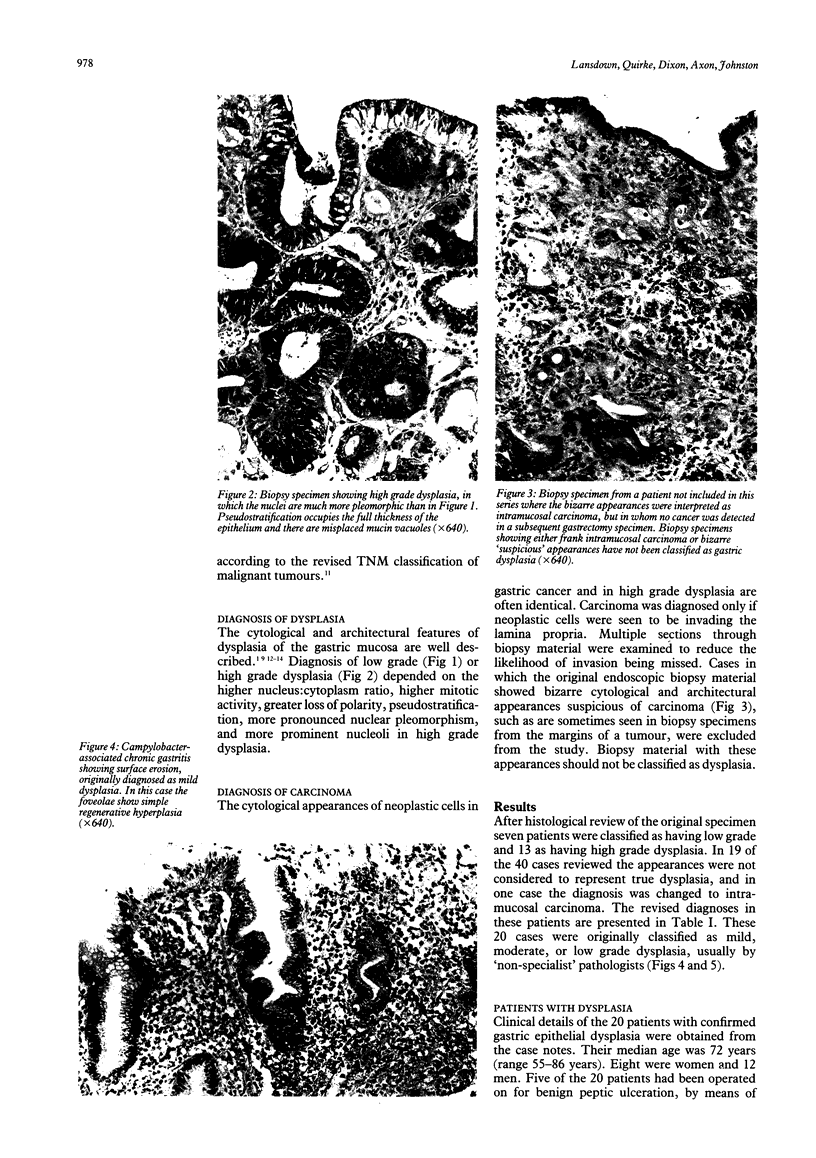

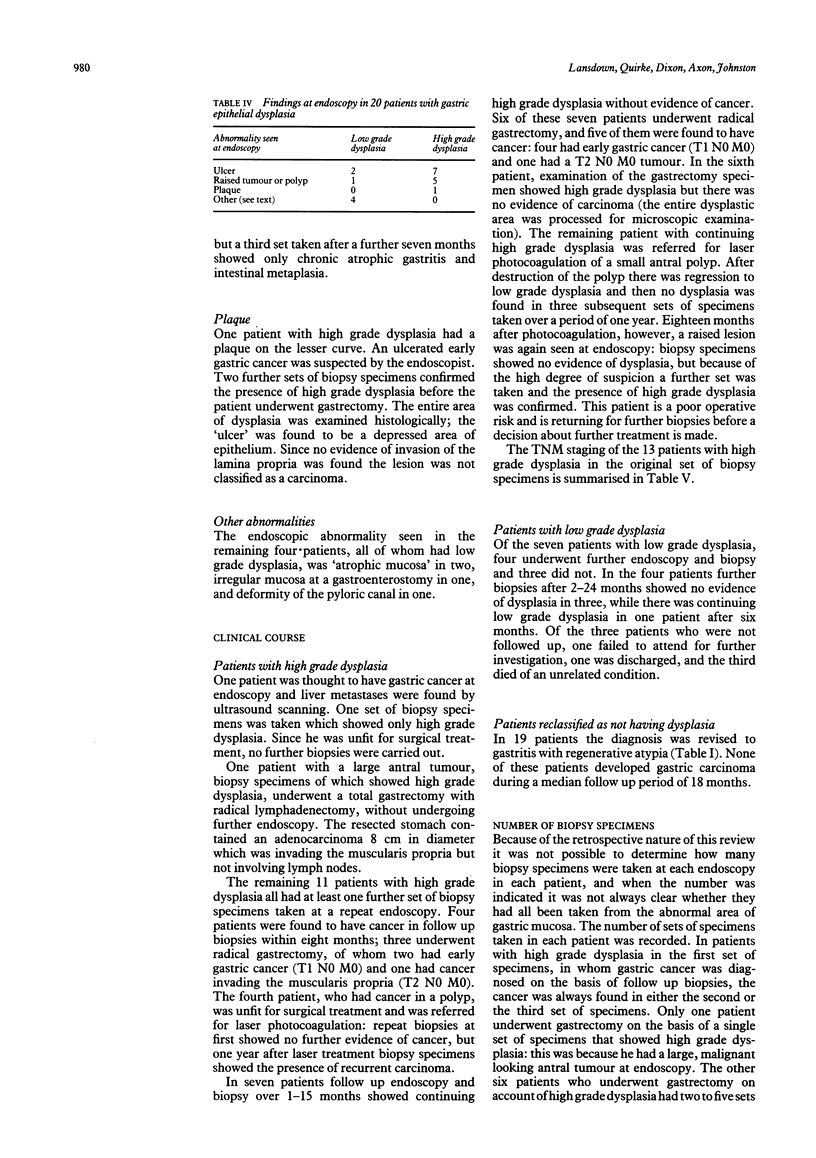


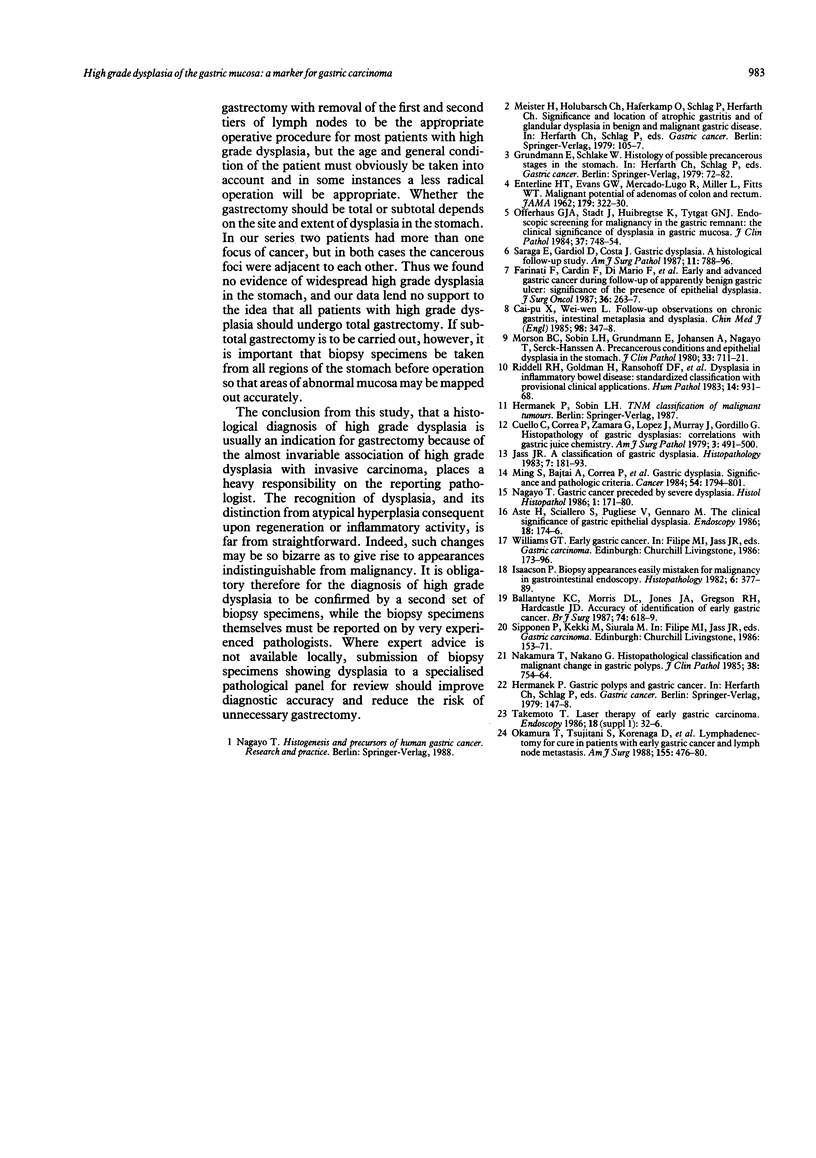
Images in this article
Selected References
These references are in PubMed. This may not be the complete list of references from this article.
- Aste H., Sciallero S., Pugliese V., Gennaro M. The clinical significance of gastric epithelial dysplasia. Endoscopy. 1986 Sep;18(5):174–176. doi: 10.1055/s-2007-1018365. [DOI] [PubMed] [Google Scholar]
- Ballantyne K. C., Morris D. L., Jones J. A., Gregson R. H., Hardcastle J. D. Accuracy of identification of early gastric cancer. Br J Surg. 1987 Jul;74(7):618–619. doi: 10.1002/bjs.1800740728. [DOI] [PubMed] [Google Scholar]
- Cuello C., López J., Correa P., Murray J., Zarama G., Gordillo G. Histopathology of gastric dysplasias: correlations with gastric juice chemistry. Am J Surg Pathol. 1979 Dec;3(6):491–500. doi: 10.1097/00000478-197912000-00002. [DOI] [PubMed] [Google Scholar]
- ENTERLINE H. T., EVANS G. W., MERCUDO-LUGO R., MILLER L., FITTS W. T., Jr Malignant potential of adenomas of colon and rectum. JAMA. 1962 Feb 3;179:322–330. doi: 10.1001/jama.1962.03050050012003. [DOI] [PubMed] [Google Scholar]
- Farinati F., Cardin F., Di Mario F., Vianello F., Battaglia G., Arslan-Pagnini C., Cannizzaro R., Sava G. A., Rugge M., Naccarato R. Early and advanced gastric cancer during follow-up of apparently benign gastric ulcer: significance of the presence of epithelial dysplasia. J Surg Oncol. 1987 Dec;36(4):263–267. doi: 10.1002/jso.2930360410. [DOI] [PubMed] [Google Scholar]
- Isaacson P. Biopsy appearances easily mistaken for malignancy in gastrointestinal endoscopy. Histopathology. 1982 Jul;6(4):377–389. doi: 10.1111/j.1365-2559.1982.tb02735.x. [DOI] [PubMed] [Google Scholar]
- Jass J. R. A classification of gastric dysplasia. Histopathology. 1983 Mar;7(2):181–193. doi: 10.1111/j.1365-2559.1983.tb02234.x. [DOI] [PubMed] [Google Scholar]
- Ming S. C., Bajtai A., Correa P., Elster K., Jarvi O. H., Munoz N., Nagayo T., Stemmerman G. N. Gastric dysplasia. Significance and pathologic criteria. Cancer. 1984 Nov 1;54(9):1794–1801. doi: 10.1002/1097-0142(19841101)54:9<1794::aid-cncr2820540907>3.0.co;2-w. [DOI] [PubMed] [Google Scholar]
- Morson B. C., Sobin L. H., Grundmann E., Johansen A., Nagayo T., Serck-Hanssen A. Precancerous conditions and epithelial dysplasia in the stomach. J Clin Pathol. 1980 Aug;33(8):711–721. doi: 10.1136/jcp.33.8.711. [DOI] [PMC free article] [PubMed] [Google Scholar]
- Nagayo T. Gastric cancer preceded by severe dysplasia. Histol Histopathol. 1986 Apr;1(2):171–180. [PubMed] [Google Scholar]
- Nakamura T., Nakano G. Histopathological classification and malignant change in gastric polyps. J Clin Pathol. 1985 Jul;38(7):754–764. doi: 10.1136/jcp.38.7.754. [DOI] [PMC free article] [PubMed] [Google Scholar]
- Offerhaus G. J., Stadt J., Huibregtse K., Tytgat G. Endoscopic screening for malignancy in the gastric remnant: the clinical significance of dysplasia in gastric mucosa. J Clin Pathol. 1984 Jul;37(7):748–754. doi: 10.1136/jcp.37.7.748. [DOI] [PMC free article] [PubMed] [Google Scholar]
- Okamura T., Tsujitani S., Korenaga D., Haraguchi M., Baba H., Hiramoto Y., Sugimachi K. Lymphadenectomy for cure in patients with early gastric cancer and lymph node metastasis. Am J Surg. 1988 Mar;155(3):476–480. doi: 10.1016/s0002-9610(88)80116-8. [DOI] [PubMed] [Google Scholar]
- Riddell R. H., Goldman H., Ransohoff D. F., Appelman H. D., Fenoglio C. M., Haggitt R. C., Ahren C., Correa P., Hamilton S. R., Morson B. C. Dysplasia in inflammatory bowel disease: standardized classification with provisional clinical applications. Hum Pathol. 1983 Nov;14(11):931–968. doi: 10.1016/s0046-8177(83)80175-0. [DOI] [PubMed] [Google Scholar]
- Saraga E. P., Gardiol D., Costa J. Gastric dysplasia. A histological follow-up study. Am J Surg Pathol. 1987 Oct;11(10):788–796. [PubMed] [Google Scholar]
- Takemoto T. Laser therapy of early gastric carcinoma. Endoscopy. 1986 Mar;18 (Suppl 1):32–36. doi: 10.1055/s-2007-1018406. [DOI] [PubMed] [Google Scholar]



